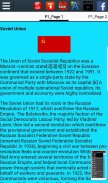








History of the Soviet Union

History of the Soviet Union介绍
The Union of Soviet Socialist Republics[b] (USSR),[c] commonly known as the Soviet Union,[d] was a socialist state in Eurasia that existed from 30 December 1922 to 26 December 1991.[9] Nominally a union of multiple national Soviet republics,[e] its government and economy were highly centralized. The country was a one-party state, governed by the Communist Party with Moscow as its capital in its largest republic, the Russian Soviet Federative Socialist Republic (Russian SFSR). Other major urban centres were Leningrad, Kiev, Minsk, Alma-Ata, and Novosibirsk.
Extending across the entirety of Northern Asia and much of Eastern Europe, the Soviet Union had spanned eleven time zones and incorporated a wide range of environments and landforms. From northwest to southeast, the Soviet Union shared land borders with Norway, Finland, Poland, Czechoslovakia, Hungary, Romania, Turkey, Iran, Afghanistan, China, Mongolia, and North Korea. It shared its maritime borders with Japan by the Sea of Okhotsk and the US state of Alaska across the Bering Strait. With an area of 22,402,200 square kilometres (8,649,500 sq mi), the Soviet Union was the largest country in the world by area, covering more than one-eighth of the Earth's inhabited land area,[10][11][12] and the third most populous, with over 288 million people as of 1989, with 80% of the population living in the western, European part of the country.
The Soviet Union had its roots in the October Revolution of 1917, when the Bolsheviks led by Vladimir Lenin overthrew the Russian Provisional Government which had replaced Tsar Nicholas II during World War I. In 1922, the Soviet Union was formed by the Treaty on the Creation of the USSR which legalized the unification of the Russian, Transcaucasian, Ukrainian and Byelorussian republics that had occurred from 1918. Following Lenin's death in 1924 and a brief power struggle, Joseph Stalin came to power in the mid-1920s. Stalin committed the state's ideology to Marxism–Leninism (which he created) and constructed a command economy which led to a period of rapid industrialization and collectivization. During this period of totalitarian rule, political paranoia fermented and the late-1930s Great Purge removed Stalin's opponents within and outside of the party via arbitrary arrests and persecutions of many people, resulting in over 600,000 deaths.[13] Suppression of political critics and forced labor were carried out by Stalin's government. In 1933, a major famine that became known as the Holodomor in Soviet Ukraine struck multiple Soviet grain-growing regions, causing the deaths of some 3 to 7 million people.[14]
In August 1939, days before the start of World War II, the Soviets signed the Molotov–Ribbentrop Pact agreeing to non-aggression with Germany, after which the two countries invaded Poland in September 1939. In June 1941, the pact collapsed as Germany turned to attack the Soviet Union, opening the largest and bloodiest theatre of war in history. Soviet war casualties accounted for the highest proportion of the conflict in the effort of acquiring the upper hand over Axis forces at intense battles such as Stalingrad and Kursk. The territories overtaken by the Red Army became satellite states of the Soviet Union and the postwar division of Europe into capitalist and communist halves would lead to increased tensions with the West, led by the United States of America.
苏维埃社会主义共和国联盟[b](苏联),[c]俗称苏联,[d]是欧亚大陆的一个社会主义国家,存在于1922年12月30日至1991年12月26日。[9]名义上是多个国家苏维埃共和国的联盟,其政府和经济高度集中。该国是一党制国家,由共产党统治,莫斯科是其最大的共和国 - 俄罗斯苏维埃联邦社会主义共和国(俄罗斯SFSR)的首都。其他主要的城市中心是列宁格勒,基辅,明斯克,阿拉木图和新西伯利亚。
苏联横跨整个北亚和东欧大部分地区,跨越了11个时区,并融入了广泛的环境和地貌。从西北到东南,苏联与挪威,芬兰,波兰,捷克斯洛伐克,匈牙利,罗马尼亚,土耳其,伊朗,阿富汗,中国,蒙古和朝鲜共享陆地边界。它与鄂霍茨克海和美国阿拉斯加州隔海相望,横跨白令海峡。苏联面积为22,402,200平方公里(8,649,500平方英里),是世界上面积最大的国家,占地球有人居住土地面积的八分之一以上,[10] [11] [12]人口第三,截至1989年,人口超过2.88亿,其中80%的人口居住在该国西部的欧洲部分地区。
苏联的根源在于1917年的十月革命,当时由弗拉基米尔·列宁领导的布尔什维克推翻了在第一次世界大战期间取代沙皇尼古拉二世的俄罗斯临时政府。1922年,苏联由“创造条约”组成。苏联使1918年发生的俄罗斯,外高加索,乌克兰和白俄罗斯共和国统一合法化。1924年列宁逝世和短暂的权力斗争后,约瑟夫斯大林在20世纪20年代中期上台执政。斯大林将国家的意识形态归功于马克思列宁主义(他创造的),并构建了一个指挥经济,导致了一个快速的工业化和集体化的时期。在极权主义统治时期,政治妄想症发酵,20世纪30年代后期的大清洗通过任意逮捕和迫害许多人,取消了斯大林党内外的反对者,导致60多万人死亡。[13]斯大林政府对政治批评和强迫劳动进行了镇压。 1933年,一场在苏联乌克兰被称为大饥荒的大饥荒袭击了多个苏联粮食种植区,导致约300万至700万人死亡。[14]
1939年8月,即第二次世界大战开始前几天,苏联签署了莫洛托夫 - 里宾特洛甫条约同意不侵略德国,之后两国于1939年9月入侵波兰。1941年6月,随着德国的转变,该协议崩溃攻打苏联,开启历史上规模最大,最血腥的战争剧场。在斯大林格勒和库尔斯克等激烈战斗中,苏联战争伤亡占据了轴心国部队优势的冲突比例最高。被红军取代的领土成为苏联的卫星国,战后将欧洲划分为资本主义和共产主义的一半将导致与美国领导的西方国家之间的紧张局势加剧。

























